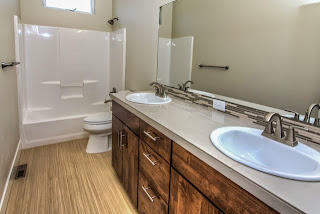Linoleum
As a home builder, I know that choosing your flooring can be one of the hardest parts of decorating the interior of your home. The first step is to choose what type of flooring that you want –tile, carpet, or a beautiful hardwood. Many home owners choose linoleum flooring for the desirable sustainable qualities and modern appeal.
Linoleum is made from linseed oil, rosin (from pine trees), wood flour, limestone, pigments and jute. Linseed oil is obtained from flax, and is the most essential ingredient in linoleum. Rosin is a binding agent, and contributes to the flexibility of linoleum. Jute is used for the backing material. In residential housing, it can be seen in kitchens, bathrooms, utility rooms and mud rooms. It also is commonly used in commercial buildings, like schools and hospitals, for its durability and anti-bacterial qualities.
What makes linoleum environmentally friendly?
The most popular aspect of linoleum is how Eco-friendly it is:
- Linoleum is made from renewable, natural materials
- Pigments used do not contain heavy metals
- Overall low toxicity levels
- Can be installed with environmentally-friendly adhesives
- Has a lifespan of typically 25-40 years, meaning less waste
- When it comes time to replace your linoleum. it is easily recyclable, making it part of a closed-loop system
This is an impressive list of Eco-friendly qualities!
What are some other need-to-know facts about linoleum?
Linoleum has many other great qualities, aside from being green:
- Low-maintenance
- Through-body product, so it wears well and can be easily repaired with little expense
- Contains natural anti-bacterial and anti-static properties
- Comes in a variety of colors and patterns to fit many design styles
- Can be installed in tiles, planks and sheets
- Can be used for other applications besides flooring, such as counters and wall panels
How does linoleum compare to vinyl flooring?
Each type of flooring surface has unique qualities and vary in their aesthetics, maintenance, and applications.
The words linoleum and vinyl are commonly used interchangeably, but these two products have major differences, even if not everyone knows them. In fact, these two products couldn’t be more different! Vinyl is a synthetic petroleum-based product, and does not contain the same environmental qualities as linoleum. Though vinyl is generally less expensive than linoleum, it typically isn’t as durable or long lasting.
Who makes linoleum?
Forbo Flooring Systems is one of the major producers of linoleum products.
You may have heard of Marmoleum. Marmoleum is part of the linoleum collection, which includes many patterns, such as marbled designs, concrete and solid colors. I love using Marmoleum when I am adding a modern appeal to an Eco-friendly design.
Other things to consider about linoleum:
- Some people may find they are sensitive to the scent of linseed oil, especially after it is first installed.
- Linoleum may develop a yellow hue on the surface from the oxidation of the linseed oil; this yellowing will disappear after exposure to light, however.
- Generally, you will want to use a mild cleaning solution as linoleum is susceptible to alkalinity.
This article was provided by Arbor Builders
This post is shared at Healthy, Happy, Green & Natural Party Hop and Lou Lou Girls Fabulous Party

